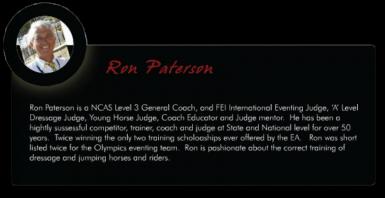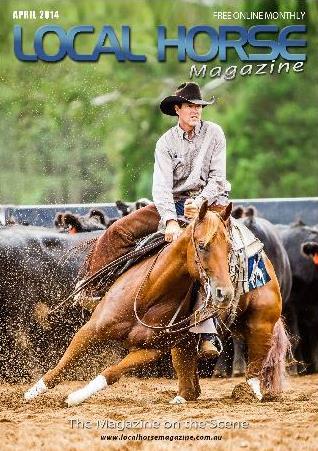Horsezone News
Dressage for Showjumpers
By: Ron Paterson - from the April 2014 Issue of Local Horse Magazine
 Are you and your horse connected?
Are you and your horse connected?
We're told from virtually our very first riding lesson that the horse's power is in his hindquarters, but do we really think about this, do we really take on board its importance?
The generation of power and energy in the horse's hindquarters and the enhancement of controlled power is of vital importance for our showjumping horses. What we must strive for is the engagement of that power to allow the energy there to be used to its greatest advantage: a projectile from behind that has the thrust that carries upwards and forwards, rather than what we often see, a horse lifting from the front, with the useful power being left to simply follow on behind.
To really make the best use of our horse's “engine” we must have the horse “connected” - and he must be connected from the “back to the front” no “the front to the back”. (diagram) This is a “feeling” that the rider must develop and as we are all different, some riders will “feel” the concept of connection more readily than others. A big help in developing this “feel” is to watch other riders on their horses. Once you can “see” whether a rider has their horse “connected” you will more readily understand the feeling of that connection yourself. There should be a sense of harmony between the horse and rider. The horse will be round, coming to a contact and exhibiting the sensation that it has “picked up” the rider and is truly carrying him; as if the rider is sitting on a springboard rather than in a hammock!
When the horse has not been trained to a connection there is usually a picture of confusion, tenseness and resistance to the rider's aids.
The importance of following the correct and accepted Training Scale: Rhythm, Suppleness, Contact, Impulsion, Straightness and Collection. With a green inexperienced horse we must first create a rhythmical and regular, relaxed forward movement with the suppleness that allows a ready acceptance of basic “direction: Then there must be the development of the acceptance of the “contact”. The aim is to develop the feeling that the rider is in control of the back and the hind legs. This is achieved by holding with the reins and simultaneously using the necessary driving aides to push the horse forward and engage the hind legs.
This is the concept of the “half-halt”, another often spoken of technique that is hard to feel and learn, there is a real tendency to allow the horse to simply “lean” on the hand with the rider confusing this with “having a contact”. This simply allows the horse to become heavy in the hand, used to leaning and ultimately falling on the forehand – exactly the opposite to what we are tyring to create! Similarly there is often the lack of actually taking hold of a contact and therefore training the horse t not correctly work “over the back”. This allows the horse to stiffen through the back, lose adjustability between fences and to develop a tendency to jump flat at the fence rather than promote a correct bascule.
As riders, many of us do not know how to correctly ride half-halts and certainly most of us do not use them nearly enough in our training. To me, correctly training the acceptance of the half-halt develops communication, the silent conversation that we must have between the horse and rider. “stop/start”, “wait with me:, “don’t run away”, “come on”, “we need a little more”, “turn here”, “no, my line, my speed”.
Once your horse is happy taking you forward on your line and speed in walk, trot and canter, the more transitions and half-halts you do the more your horse physically develops, to bring his hind legs under him and work over the back. Rider will bring about a response by the horse.
“Transitions” here does not just mean changing pace, but transitions within each pace as well (going on, coming back) where the half-halt is of utmost importance.
The half-halt actually enhances the mental development of the horse, with the horse and rider combination developing a greater confidence in each other. Ultimately the slightest indication, even thought, from the rider will bring about a response by the horse.
Probably the most common failures in the showjumping arena are due to the very basic concepts of “your line” or “your speed” with the desired “engagement”. By correctly training to enhance a proper “connection” these concepts will develop and just become second nature.

Horsezone is pleased to be working with Local Horse Magazine and welcomes their contributions. For more great articles like this one and live streaming from a wide range of events Australia wide - go to www.localhorsemagazine.com.au
News Search
Categories
- General
- Event Results
- Stallionzone
- Sponsored Shows
- Clubs
- Health
- Feature Horses
- Competitions
- Five Minutes With Horsezone
- Young Riders
- Reviews
- Training and Clinics
- Postcards from the saddle
- 2014 Equitana by HORSE FIRST
- 2013 Equitana
- 2012 Equitana
- 2012 London
- 2011 Equitana
- 2011 Queensland Floods
- 2010 WEG

